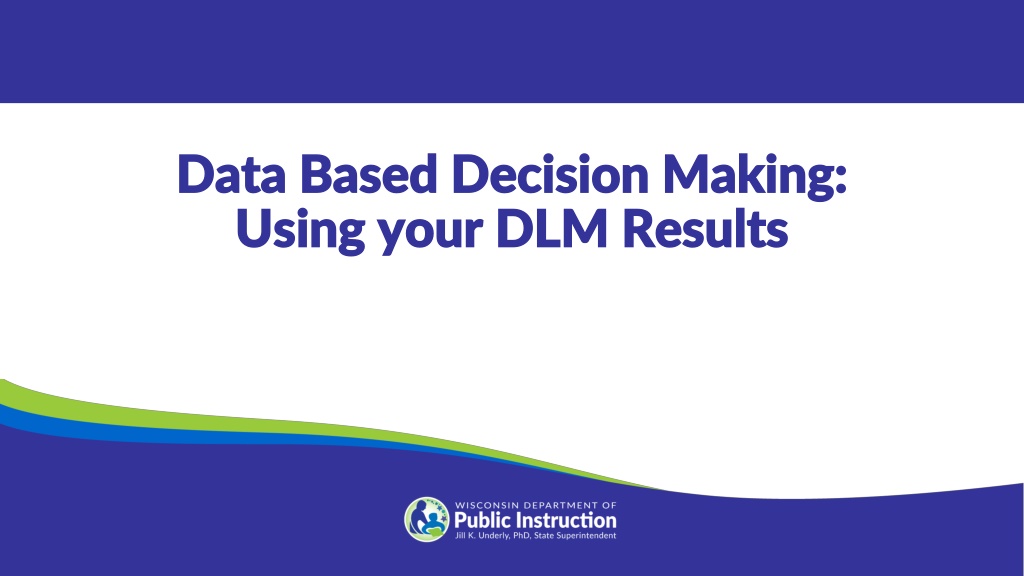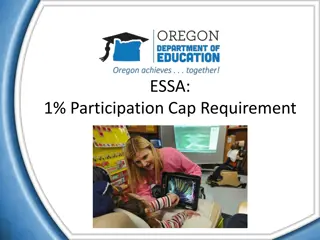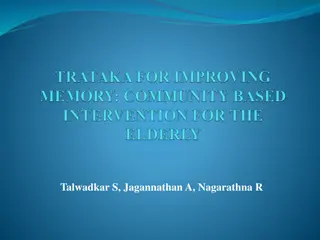Understanding DLM Alternate Assessments for Students with Cognitive Disabilities
Discover the purpose and structure of DLM Alternate Assessments designed for students with significant cognitive disabilities. Learn how results are used for instructional planning and monitoring. Explore the coverage of Essential Elements, Claims, and Conceptual Areas to guide assessment strategies effectively.
Download Presentation

Please find below an Image/Link to download the presentation.
The content on the website is provided AS IS for your information and personal use only. It may not be sold, licensed, or shared on other websites without obtaining consent from the author. Download presentation by click this link. If you encounter any issues during the download, it is possible that the publisher has removed the file from their server.
E N D
Presentation Transcript
Data Based Decision Making: Data Based Decision Making: Using your DLM Results Using your DLM Results
Overview Reminders about DLM alternate assessments Overview of the Individual Student Score Reports How to read each profile Suggested uses for each profile
Purpose of DLM Alternate Assessments Purpose of DLM Alternate Assessments DLM alternate assessments measure what students with the most significant cognitive disabilities know and can do Results from DLM alternate assessments are intended to be used for instructional planning, monitoring, and adjustment Some states use for additional purposes
DLM Alternate Assessment Reminders Assessment covers Essential Elements Claims Conceptual Areas English language arts and mathematics are grouped in conceptual areas and claims Essential Elements
DLM Alternate Assessment Reminders Assessment covers Essential Elements Topics Domains Science are grouped in domains and topics Essential Elements
DLM Alternate Assessment Reminders DLM Alternate Assessment Reminders The blueprint specifies which Essential Elements are available for testing within each Conceptual Area Each student is expected to test on all Essential Elements in the grade-level blueprint
DLM Alternate Assessment Reminders DLM Alternate Assessment Reminders Each Essential Element consists of linkage levels of varying complexity Each linkage level has a testlet Students may take testlets (short tests) on one or more linkage levels per Essential Element
DLM Alternate Assessment Reminders Linkage Levels in an Essential Element Testlets Increasing complexity
Key Points Key Points Results are based on student mastery of linkage levels for each EE Linkage levels are called skills in the report Results are based on all linkage levels not just the ones tested
Performance Profile in Detail 18 x 5 = 90
Total Skills Mastered Add the number of skills mastered across all Essential Elements for that grade and subject
Grade/Content Performance Level Descriptors
Suggestions for Using Performance Profiles Suggestions for Using Performance Profiles Developing IEPs Communication with parents Communication with other educators
Learning Profile
Learning Profile Learning Profile Elements of the Table Elements of the Table Essential Elements Levels Skill Key
Skill Mastery 1 Initial Precursor Understand the function of objects Identify concrete details in an informational text 2 Distal Precursor Essential Element Recognize how titles reflect text structure and text purpose Proximal Precursor 3 ELA.RI.7.5 4 Target Understand sequencing Understand how parts of the text affect overall text structure 5 Successor
Skill Mastery 1 Initial Precursor Understand the function of objects Identify concrete details in an informational text 2 Distal Precursor Essential Element Recognize how titles reflect text structure and text purpose Proximal Precursor 3 ELA.RI.7.5 4 Target Understand sequencing Understand how parts of the text affect overall text structure 5 Successor
Initial Precursor 1 Understand the function of objects Essential Element Identify concrete details in an informational text Distal Precursor 2 Recognize how titles reflect text structure and text purpose Proximal Precursor 3 ELA.RI.7.5 Target 4 Understand sequencing Understand how parts of the text affect overall text structure Successor 5
Level of Mastery Conceptual Area Essential Element
Learning Profile, cont. Learning Profile, cont.
Suggestions for Using the Learning Profile Suggestions for Using the Learning Profile Communicate with Parents Use to explain the Performance Profile Describe the student s present levels of performance when developing an IEP or other report
Suggestions for Using the Learning Profile Suggestions for Using the Learning Profile Set instructional goals - Connect previous grade s EEs to current grade Identify strengths and weaknesses Guide goal development for a standards-based IEP Professional development module available at dlmpd.com
Individual Student Report Summarizes information from the Performance Profile Incorporates social studies for students in grades 4, 8 and 10 Easy to print/mail format for parents
Individual Student Report Consistent with the tables on the performance profile.
Cautions Cautions Results are based on the information from a single assessment Results are based on best estimates of mastery probability using a limited number of items Results are not intended to be used to make decisions about retention, placement, or disability eligibility
WISEdash WISEdash Administrators have access to longitudinal data in WISEdash under Student Profiles Can use to see trends and compare to state level data
Data Inquiry Data Inquiry What is your district doing? How does this impact the work you do on a day-to-day basis? Do you have opportunities to work with content/ general education teams?
3 8 PLC Data Inquiry Process PLC Data Inquiry Process What do we need to know about student learning? Which data best indicate students are learning? Why? Why? What targets? What targets? Why did we meet or not meet all student needs? How? How? What data? What data? How will we adjust our teaching?
3 9 Curriculum Curriculum What do we need to know about student learning? What targets? What targets? What knowledge, skills, understandings and dispositions will students need to progress toward other learning targets? To what degree do we all understand the guaranteed and viable curriculum for all students and its importance in our PLC work? Based on our curriculum, what are the learning targets that we expect our students to know and be able to do at this time?
4 0 Data Collection Data Collection What does achievement of the learning target look look like when students meet performance indicators (knowledge, conceptual understanding and application of skills)? What What data? data? Which data best indicate students are learning? What patterns do we see in our data? How have we assessed these learning targets? Are there achievement gaps between groups of students? What data tells us about student achievement of the learning targets? How should we assess the content and rigor of these learning targets? Which students seemed to struggle and which students seemed to excel, based on the data? Do we all have the data in a format for us to study?
4 1 Looking at the Data Looking at the Data Why did we meet or not meet all student needs? Why? Why? Why did our strategies lead some students to meet or exceed the learning targets and others to not meet the targets? Which specific strategies seemed to have the highest percentage of success? What strategies were used to overcome the barriers to learning that some students experience (absenteeism, disabilities, language, etc.) ? Why do you think these strategies worked?
4 2 Planning Planning How? How? How will we adjust our teaching? What core instructional strategies will we use to help all students become ready for their next learning? What core instructional strategies will we use if students are ready to move beyond our current expectations? Which strategies were successful for which learners? What core instructional strategies will we use to increase student engagement? What core instructional strategies will we use for students who haven t met the expected performance level? What core instructional strategies will we use to help students apply their learning in different situations? What more do we need to learn about our core instruction and student learning?
4 3 Your Thoughts about PLC Inquiry Your Thoughts about PLC Inquiry What are your observations about PLCs in your schools? To what degree are they embedding inquiry within their collaborative work? How can you use the inquiry process in your role as an instructional leader?
Discussion and Dialogue Discussion and Dialogue
Thank you Thank you Send Questions to: osamail@dpi.wi.gov























